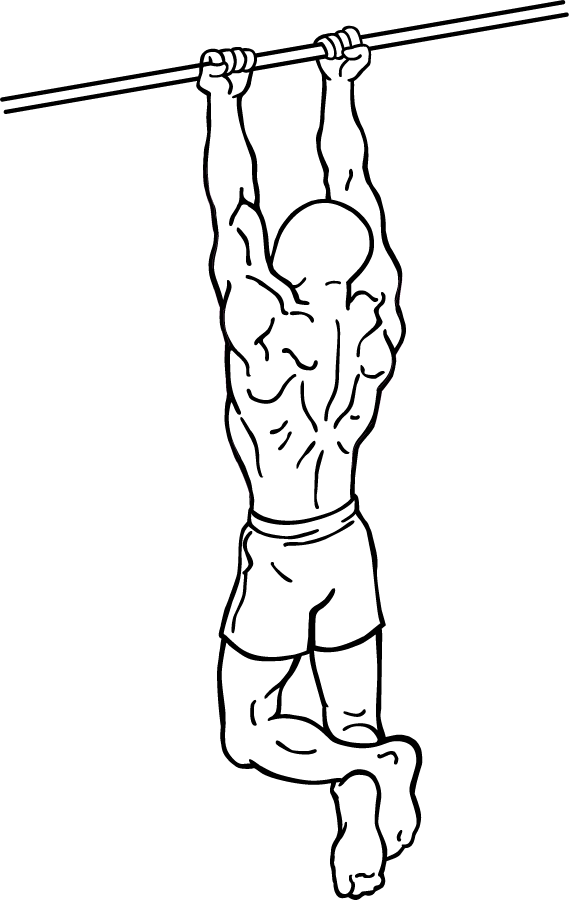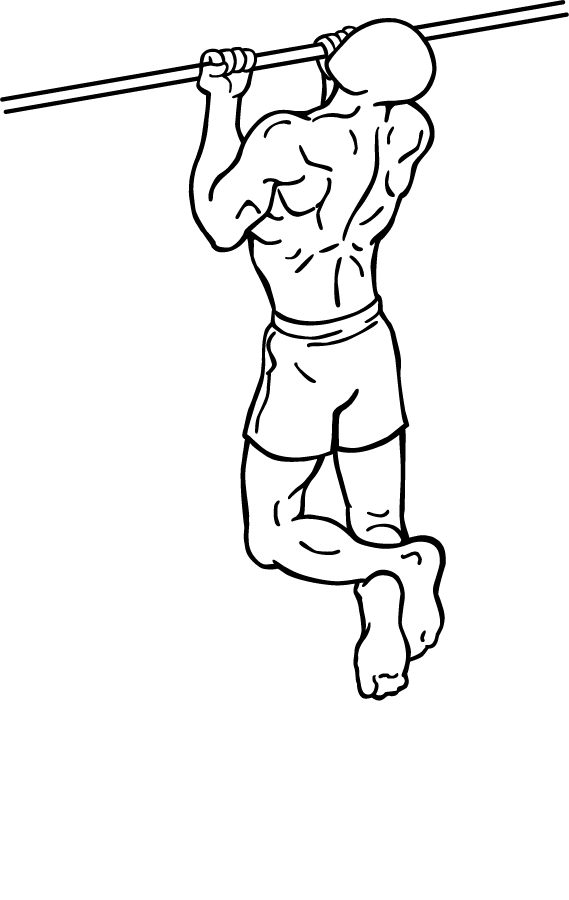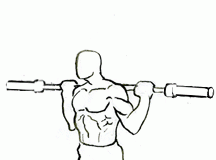Last Updated on September 30, 2014
When it comes to building upper body strength, few exercises compare to the effectiveness of the chin-up. Chin-ups are a classic bodyweight exercise that targets a wide range of muscles, particularly the upper arms, shoulders, and middle back. Whether you’re a fitness beginner or a seasoned gym-goer, chin-ups are a powerful addition to your workout routine. In this guide, we’ll explore everything you need to know about chin-ups, from proper technique and form to the significant benefits and variations to challenge your muscles further. If you’re aiming to optimize your upper body strength and enhance your physique, chin-ups should be a staple in your training program.
What Are Chin Ups?
Chin-ups involve pulling your body weight upward by gripping a fixed bar and raising your chin above the bar. This simple yet challenging exercise engages multiple muscle groups, making it a compound movement that effectively builds strength and muscle endurance. The primary muscles worked during chin-ups include the biceps, latissimus dorsi (lats), and other muscles of the upper back and shoulders.
While chin-ups might seem similar to pull-ups, the key difference lies in the grip. Chin-ups are performed with an underhand (supinated) grip, meaning your palms face toward you, while pull-ups typically use an overhand (pronated) grip. This subtle change in grip placement shifts the focus slightly, making chin-ups particularly effective at engaging the biceps.
Muscles Targeted During Chin Ups
One of the biggest advantages of chin-ups is their ability to work multiple muscle groups simultaneously. Here’s a breakdown of the key muscles targeted:
- Biceps Brachii: As you pull your body upward during a chin-up, your biceps are the primary movers, contracting to lift your body weight.
- Latissimus Dorsi (Lats): The large muscles of your middle back are heavily engaged during chin-ups, helping to pull your body toward the bar.
- Trapezius: These muscles, located in the upper back and neck, play a role in stabilizing the shoulders and supporting the pull motion.
- Rhomboids: These smaller muscles between the shoulder blades work to retract the shoulders during the movement, promoting a strong and stable back.
- Forearms and Grip Strength: Chin-ups also challenge your grip strength and forearms as you hold onto the bar throughout the exercise.
By targeting these major muscle groups, chin-ups are an efficient way to build functional strength, improve posture, and enhance muscle definition.
The Benefits of Chin Ups
Chin-ups offer numerous benefits that extend beyond mere muscle growth. Here’s why you should include chin-ups in your workout routine:
- Improved Upper Body Strength: Chin-ups are one of the most effective exercises for building strength in the arms, back, and shoulders. Regularly performing chin-ups can lead to significant increases in muscle power and endurance.
- Core Engagement: While chin-ups primarily target the upper body, they also require you to engage your core muscles to stabilize your body throughout the movement. This added core activation can help improve overall core strength and stability.
- Functional Fitness: Chin-ups simulate a natural pulling motion that mimics real-life movements, making them a great exercise for improving functional strength and daily activities such as lifting, carrying, and pulling objects.
- Grip and Forearm Strength: Holding onto the bar during chin-ups works the muscles in your hands and forearms, improving grip strength and endurance. Stronger grip strength translates to better performance in other exercises and activities.
- Posture Improvement: Strengthening the muscles of the back and shoulders can lead to better posture. Chin-ups help counteract the effects of poor posture from prolonged sitting or desk work by reinforcing the muscles that support the spine.
- Increased Muscle Definition: If you’re aiming for a more sculpted physique, chin-ups are an excellent exercise for building muscle definition in the arms, back, and shoulders. The pulling motion stimulates muscle growth and contributes to a toned appearance.
- Boosted Confidence: Chin-ups are challenging but rewarding. As you progress and become stronger, you’ll likely feel a sense of accomplishment and increased confidence in your physical abilities.
Proper Technique: How to Do Chin Ups Correctly
Mastering the correct form for chin-ups is crucial for maximizing results and minimizing the risk of injury. Here’s a step-by-step guide to performing chin-ups with perfect technique:
- Grip the Bar: Start by standing underneath a pull-up bar. Reach up and grasp the bar with a supinated (underhand) grip, with your palms facing toward you. Your hands should be about shoulder-width apart. Ensure you have a firm grip before starting the movement.
- Hang from the Bar: Once you have a secure grip, let your body hang from the bar with your arms fully extended. Your feet should be off the ground, and your body should remain in a straight line. Engage your core muscles to stabilize your body and avoid excessive swinging.
- Initiate the Pull: Begin the upward movement by pulling your shoulder blades down and back, initiating the pull from your back muscles rather than just your arms. Continue to pull your body upward by bending your elbows and contracting your biceps and lats.
- Reach Chin Over the Bar: As you continue pulling, aim to bring your chin above the bar. Keep your neck neutral and avoid craning your head forward to meet the bar.
- Controlled Lowering: After reaching the top position, slowly lower your body back to the starting position in a controlled manner. Resist the temptation to drop quickly, as the lowering phase (eccentric portion) is just as important for muscle development.
- Repeat the Movement: Continue performing repetitions, maintaining proper form throughout each chin-up. Focus on engaging your back, biceps, and core to perform each repetition with control and strength.
Tips for Success: Maximizing Your Chin Up Performance
Achieving success with chin-ups requires practice, patience, and attention to detail. Here are some essential tips to help you get the most out of this exercise:
- Warm Up Properly: Before attempting chin-ups, be sure to warm up your muscles with dynamic stretches and mobility exercises. This helps prepare your body for the movement and reduces the risk of injury.
- Focus on Form: It’s crucial to prioritize proper form over the number of repetitions. Performing chin-ups with poor form can lead to imbalances or injuries. Keep your movements controlled and avoid using momentum to lift your body.
- Engage Your Core: Throughout the exercise, make sure to engage your core muscles to stabilize your body. A strong core helps prevent swinging or arching during the movement, allowing you to maintain control and prevent strain on your lower back.
- Avoid Kipping: Kipping, or using momentum to swing your body upward, is often seen in CrossFit-style pull-ups. However, for chin-ups, it’s best to avoid kipping and focus on strict, controlled movements. This ensures that you’re properly engaging the targeted muscles and maximizing strength gains.
- Practice Progressions: If you’re new to chin-ups or find them too challenging, don’t be discouraged. You can build up to full chin-ups by practicing easier progressions such as negative chin-ups (focusing on the lowering phase), assisted chin-ups using resistance bands, or chin-ups with the help of a spotter.
- Progress Gradually: As you become more comfortable with chin-ups, gradually increase the number of repetitions or add resistance by using a weighted vest or holding a dumbbell between your legs. This progressive overload will help you continue building strength over time.
Chin Up Variations: Taking Your Training to the Next Level
Once you’ve mastered the basic chin-up, there are several variations you can try to add variety to your workouts and challenge your muscles in new ways:
- Weighted Chin Ups: Once you’ve built up enough strength with bodyweight chin-ups, you can add extra resistance by wearing a weighted vest or holding a dumbbell between your legs. This variation increases the intensity of the exercise and promotes further muscle growth.
- Neutral Grip Chin Ups: Instead of using a supinated grip, try performing chin-ups with a neutral grip, where your palms face each other. This variation places less strain on the wrists and can help target the muscles of the arms and back in a slightly different way.
- Close Grip Chin Ups: For a more targeted biceps workout, perform chin-ups with a close grip, placing your hands closer together on the bar. This variation increases the emphasis on the biceps while still engaging the back muscles.
- Explosive Chin Ups: For advanced athletes looking to increase power and explosiveness, try explosive chin-ups. In this variation, you pull yourself up with enough force to momentarily release your hands from the bar at the top of the movement. This requires significant strength and control but can improve athletic performance.
- Eccentric Chin Ups: To focus on the lowering (eccentric) portion of the movement, try eccentric chin-ups. Start by jumping or using assistance to get your chin above the bar, then lower yourself slowly and with control. Eccentric training is excellent for building strength and improving muscle control.
Common Mistakes to Avoid During Chin Ups
While chin-ups are a fantastic exercise, there are some common mistakes that people make, which can hinder progress or increase the risk of injury. Here are a few mistakes to watch out for:
- Using Momentum: Avoid using momentum or swinging your legs to propel yourself upward. This reduces the effectiveness of the exercise and places unnecessary strain on the shoulders and lower back.
- Incomplete Range of Motion: Ensure that you complete the full range of motion during each repetition. Lower your body all the way down until your arms are fully extended, and pull yourself up until your chin is above the bar.
- Flaring Elbows: Keep your elbows close to your body during the movement. Flaring your elbows out to the sides can place undue stress on your shoulders and reduce the effectiveness of the exercise. Instead, aim to keep your elbows tucked in and focus on engaging your back and biceps.
- Not Engaging the Core: A common mistake during chin-ups is neglecting to engage the core muscles. This can lead to excessive swinging or arching of the back, which compromises the movement and increases the risk of injury. Keep your core tight and your body aligned throughout the exercise.
- Neglecting the Eccentric Phase: The lowering phase (eccentric phase) of the chin-up is just as important as the upward pull. Many people tend to rush through this part of the exercise, missing out on valuable muscle-building benefits. Take your time lowering yourself in a controlled manner to maximize muscle engagement.
How to Build Up to Your First Chin Up
Chin-ups can be intimidating for beginners, but with consistent effort and the right approach, you can build the strength needed to perform your first full chin-up. Here’s a progression plan to help you work up to achieving a chin-up:
- Negative Chin Ups: Focus on the lowering phase of the chin-up by starting at the top position (with your chin above the bar) and slowly lowering yourself down. This helps build the necessary strength in your arms and back to eventually pull yourself up.
- Assisted Chin Ups: Use resistance bands or a chin-up assist machine to help reduce the amount of body weight you need to lift. Gradually decrease the assistance as you get stronger.
- Lat Pulldowns: Incorporate lat pulldowns into your routine to strengthen your lats and simulate the pulling motion of chin-ups. This can help build the muscles needed for chin-ups.
- Bent-Over Rows: Strengthen your back muscles with exercises like bent-over rows. Building a strong back will contribute to your ability to perform chin-ups.
- Isometric Holds: Practice holding yourself at the top of the chin-up position for as long as possible. This helps build endurance and strength in the muscles required to perform the full movement.
- Gradual Progression: As you build strength, start attempting partial chin-ups, where you pull yourself up part of the way before gradually increasing the range of motion. Eventually, you’ll be able to perform a full chin-up.
Incorporating Chin Ups into Your Workout Routine
Chin-ups are a versatile exercise that can be incorporated into various workout programs. Whether you’re training for strength, endurance, or hypertrophy (muscle growth), chin-ups can play a key role in your routine. Here are some ways to integrate chin-ups into your training:
- Strength Training: For strength gains, aim to perform 3-5 sets of 3-5 reps of chin-ups, focusing on quality and proper form. Rest for 2-3 minutes between sets to allow for maximum recovery.
- Hypertrophy Training: If your goal is muscle growth, perform 3-4 sets of 8-12 reps. Keep rest periods shorter, around 60-90 seconds, to maintain intensity and promote muscle hypertrophy.
- Endurance Training: For muscular endurance, perform higher reps with lower intensity. Aim for 3-4 sets of 12-15 reps, with shorter rest periods of 30-60 seconds.
- Supersets: Combine chin-ups with another exercise, such as push-ups or squats, for a full-body superset. This approach helps you save time while increasing the intensity of your workout.
- Circuit Training: Incorporate chin-ups into a circuit training routine, where you move from one exercise to the next with minimal rest in between. This is a great way to boost cardiovascular fitness while working on strength.
Chin Ups for All Fitness Levels
One of the great things about chin-ups is that they can be adapted to suit all fitness levels. Whether you’re a beginner just starting your fitness journey or an advanced athlete looking for a new challenge, chin-ups can be tailored to meet your needs.
- Beginners: Start with assisted variations and progress gradually. Focus on building strength in your back, arms, and core through other exercises while practicing negative chin-ups and assisted chin-ups to build confidence.
- Intermediate: Once you can perform several unassisted chin-ups, aim to increase your repetitions and incorporate different variations into your routine. Try neutral grip or close grip chin-ups to target different muscles and add variety.
- Advanced: For experienced athletes, increase the difficulty by adding weights, performing explosive chin-ups, or incorporating isometric holds. You can also experiment with advanced variations like towel chin-ups (gripping a towel draped over the bar) to further challenge your grip and forearm strength.
The Power of Chin Ups in Your Fitness Journey
Chin-ups are a powerful exercise that can significantly enhance your upper body strength, improve posture, and contribute to a well-rounded physique. Whether you’re aiming to build bigger biceps, strengthen your back, or improve your overall functional fitness, chin-ups are a must-have in any workout routine.
By mastering proper form and technique, gradually progressing to more challenging variations, and consistently incorporating chin-ups into your training, you’ll unlock their full potential. Remember, it’s not about how many chin-ups you can do right away—it’s about building strength, control, and confidence over time.
So, the next time you hit the gym, challenge yourself to incorporate chin-ups into your workout. With dedication and effort, you’ll soon be reaping the rewards of this effective and versatile exercise, and you’ll be well on your way to achieving your fitness goals. Keep pushing, stay consistent, and enjoy the strength gains that come with mastering chin-ups!








